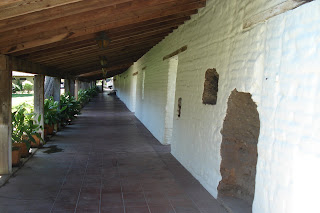 An Italian immigrant family, new to America, plants some grapevines that they brought from their homeland.
An Italian immigrant family, new to America, plants some grapevines that they brought from their homeland.100 years later a land developer in Northern California buys the property for a housing development. The vines, struggling and surviving, all these years in exile, now face the ax. They had a long life, their family is long gone, now part of the American experiment. So?
What should we do with these vines? If they came here today they would be here illegally. Maybe they brought disease within their roots, a type that isn’t right for this landscape. Sure they have adapted, and survived, often for years without care or attention. But they are in the way; they are not part of the future plan for the place. So why shouldn’t they be taken out?
 In places like Cucamonga, Hollister and Napa, the immigrant's vines are losing out. Old dreams replaced with newer ones.
In places like Cucamonga, Hollister and Napa, the immigrant's vines are losing out. Old dreams replaced with newer ones.Cabernet is more profitable in Napa, so out goes the 100 year old Petite Sirah vines, dry farmed, hearty characters. In come the McCabernets.
Mataro and Zinfandel in Hollister, must it also go back over the fence? Urban sprawl needs houses for the American citizens.
 Barbera and Calabrese vines in Cucamonga are declared enemy combatants, they are here without papers and no one knows how they got in. But they must be sequestered and all this must be sorted out.
Barbera and Calabrese vines in Cucamonga are declared enemy combatants, they are here without papers and no one knows how they got in. But they must be sequestered and all this must be sorted out.In the valleys above Santa Barbara, vines were planted by undocumented Sicilians. Damaschino, Carricante, Perricone, all must go. This is a premium area for the elite whites, Chardonnay and Sauvignon Blanc.
 In Italy, they find a neglected vine, resuscitate it, and voila a new heirloom is brought back into the family. A pile of rubble, maybe there since 65 AD, sits until someone finds a cave underneath and an ancient city and culture is brought back to life. It happens all the time. Over there.
In Italy, they find a neglected vine, resuscitate it, and voila a new heirloom is brought back into the family. A pile of rubble, maybe there since 65 AD, sits until someone finds a cave underneath and an ancient city and culture is brought back to life. It happens all the time. Over there. I visited my Alma Mater the other day. There is an adobe wall in the garden area. It was from the 1700’s, in an area where the wine was made. This wall has been restored, propped up as a reminder of the toils of others who made our present lives so much more comfortable. It happens, in little doses, often for symbolic purposes.
I visited my Alma Mater the other day. There is an adobe wall in the garden area. It was from the 1700’s, in an area where the wine was made. This wall has been restored, propped up as a reminder of the toils of others who made our present lives so much more comfortable. It happens, in little doses, often for symbolic purposes.
The sense I have gotten, these few days on the edge of the Pacific, is that the ways of those who came before us are worthy of retaining if it doesn’t get in the way of who we think we are and where we want to go. Is that any different than they way this culture acted towards the indigenous Americans in the past? How far away must we send them? Should the Calabrese grapes and the Sicilian immigrants be returned as well?
The Charbono of Ernie Fortino, the Barbera of John Filice, The Mataro of Bob Enz, have we treated these vines and humans like the treasures they are? Or have we declared them to longer be of interest to us, have we put them on their Trail of Tears?
Has the California that I grew up in long disappeared under the wall of time?


